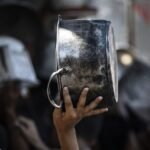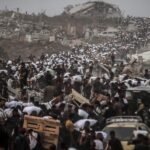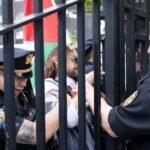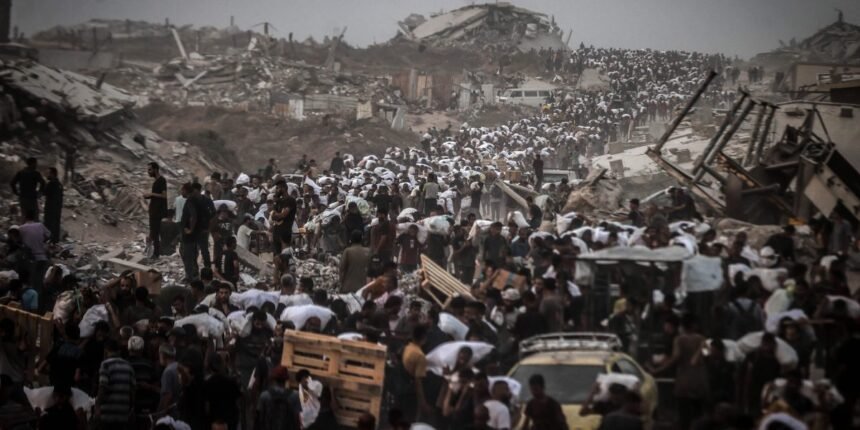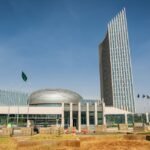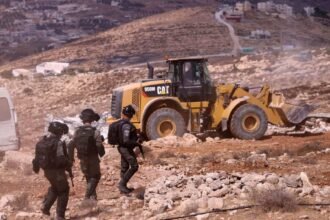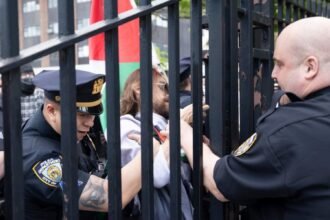24 Daily News
While ceasefire negotiations for Gaza go on, the famine in Gaza is reaching unprecedented levels, with deliberate starvation being used as a weapon by the Israeli occupation. In recent weeks, at least 63 people have died of starvation, including 25 children. The total death toll from starvation has now reached 111, with 80 of them being children.
On July 19, 2025, Mohammad al-Sawafiri, a 19-year-old Palestinian man with special needs, died from hunger under the ongoing Israeli siege. His images circulated widely on social media, showing a severely emaciated body: his skin tightly wrapped around his bones, chest sunken, limbs fragile. He lay lifeless on a thin mat, surrounded by onlookers. His face reflects suffering and exhaustion, bearing the clear signs of severe, prolonged starvation. A spokesperson from the Gaza Civil Defense warned that if humanitarian aid continues to be blocked, al-Sawafiri will not be the last.
Starved doctors are attempting to treat starved patients, while starved paramedics and civil defense teams carry them to hospitals. Starved journalists and photographers continue to report live from the scene, their voices shaking and eyes filled with tears. The pain and helplessness were especially visible this week in the voice and gaze of reporter Anas Al-Sharif.
Starved fathers roam the streets in search of food to buy to feed their starved children. They are gripped with despair, unable to provide basic nourishment as food becomes nearly impossible to find — and if available, it comes at exorbitant prices: One kilo of flour costs around 25 U.S. dollars, one kilo of lentils $16, one kilo of pasta $19, one kilo of potato $14, and one kilo of rice $22.
Never in my worst nightmares did I imagine we would face such a devastating famine. Children wander barefoot in the streets, desperately searching for a scrap of food. This week, an elderly man collapsed from hunger while waiting in line for food — pale and frail, he fainted before receiving anything.
A Ceasefire or Another Illusion?
Whenever we hear about a ceasefire or negotiations in Gaza, we always see high-profile talks announced at the beginning of the week. After that, expectations are raised, results are positive, pressures are imposed, and then, at the end of the week, the process collapses or results in half-measures that fall short of substantive change.
Each time negotiations are reported, the situation in Gaza gets worse, and the massacres increase. Famine is spreading among all of Gaza. The airstrikes have intensified brutally in recent weeks, as if to annihilate any trace of life. I worry that, if a ceasefire does come, there will be nothing left to save. Every morning, we wake up to the news of hundreds killed overnight. It has become normal to wipe out entire families and neighborhoods.
Ceasefire talks always feel like an illusion. It has been a long time since people in Gaza stopped pinning their hopes on politicians, negotiations, or what is on the world stage, because the real decisions are made behind closed doors.
I worry that, if a ceasefire does come, there will be nothing left to save.
These past two week, as negotiations between Israeli Prime Minister Benjamin Netanyahu and U.S. President Donald Trump resurfaced in media headlines — talks said to include points like humanitarian aid, a phased military withdrawal, and the elusive promise of a “permanent ceasefire” — we dared to hope again for a ceasefire to breathe. This hope feels different for us in Gaza. We feel like it could work this time. However, it also feels heavier than any time. Heavier with memory, with suffering, with dreams long deferred.
But we are hopeful that a miracle will occur by the middle or end of next week that will bring us into a 60-day ceasefire or maybe a permanent ceasefire. We always believe that this genocide will end like it began, but we do not know exactly when that can happen. It is said that Trump’s pressure is mounting on Netanyahu so that there a real possibility for a ceasefire.
I, like nearly 2 million other Palestinians living through genocide and still surviving it, still dare to believe that a ceasefire will be announced soon.
What Hope Feels Like
I remember the ceasefire in January, when displaced families like mine returned from the south of the Gaza Strip. Streets once emptied of joy were momentarily alive again. Faces across Gaza lit up with hope, cheers, and takbir.
At that ceasefire, I went out in Gaza City’s streets for the first time in weeks. My friend Dima and I walked from Omar al-Mukhtar Street to al-Rimal, past the ruins of my house, taking a picture of it as an act of farewell. We sat and ate kebabs and grilled chicken and laughed over ice cream. We were so glad that we returned from the south to the heart of Gaza, and we were so grateful that we survived with no injuries. That short-lived pause gave us a taste of what life could be — only for it to be ripped away again.
Now, with new talks underway, my friends and I are holding on by whispering hopes through prayers and voice notes via WhatsApp. My mentors and friends offer me so much strength.
Each day, I exchange voice messages with my friend Sara Awad. We talk about the day we will finally go to a restaurant, sit down, and eat until we are full, and then buy snacks like we used to. We want to sit in a quiet, open place and talk about our futures, our education, and our dreams that still breathe beneath the rubble.
On Instagram, we send each other reels of food and sweets — meals we have not seen, smelled, or even tasted for more than a year. We crave the taste of chicken, eggs, meat, juice, dairy, fruit, and fresh food. We long for sweets and candy, for Nescafé and creamy cappuccino.
I always talk with my friend Nadera, about finally meeting, talking, creating beautiful memories, and working together on interviews for a project. With my friend Dima, I dream of us going out to the sea, having our breakfast as the waves hum beside us, letting conversations about writing and life unfold with ease, listening to songs, sipping cappuccino, and just breathing.
Then there is my friend Genista. We message each other daily, each text soaked in a longing for normalcy. We always hope for the genocide to end soon so that we can go to a restaurant to eat a delicious meal. We missed our chance during the last ceasefire to meet, but we promised we will not miss the next.
What the Ceasefire Can’t Undo
No ceasefire will erase the smell of blood that clings to our memories. No ceasefire can bring back those we have lost. No one can compensate the orphans or widows. No one can delete the massacres, the death traps disguised as aid centers. No one can erase the images of bodies in pieces, of blood soaked into the floor, of children crushed beneath rubble, of injured and amputated people, of infants and fetuses killed in their mothers’ wombs, of starved people suffering from malnutrition. No one can make us forget the taste of nothing during starvation and the feeling of helplessness in front of seeing our futures destroyed.
Amid this brutal genocide in Gaza, grief is our cruel companion. It teaches us how ungentle mourning can be, how full of anger, and how it can burn your heart when you lose your loved ones.
For over 650 days, we have lived in hell, in a way that can make any human lose their sanity. We have opened our eyes not to the sound of birds or alarm clocks, but to the sounds of missiles, screams, collapsing homes, and grief too heavy for any human heart.
For months, we have lived on the edge of starvation. We have watched aid trucks become targets and aid centers turn into death traps. Israel has sealed the crossings, halting the flow of flour, canned food, hygiene kits, fruits, vegetables, and so many basic necessities. We don’t live, but barely can we survive.
For nearly two years, we have endured a genocide that has taken more than 57,000 Palestinian lives and injured hundreds of thousands more. We count the martyrs as we count the hours, and yet we still wake up every day clinging to hope for an end to this hell. In Gaza, hope is part of our existence and DNA. It is the final ember glowing amid the ruin of genocide, the last thing to die when all else is buried. It is what we breathe in the absence of fresh oxygen.
We imagine the moment a ceasefire happens — the moment a real, lasting ceasefire is declared. We imagine a new Gaza, a Gaza where dreams are blooming, not buried. We imagine Anas Al-Sharif and all journalists throwing down their press vests and helmets, shouting takbirs, and announcing a ceasefire. We imagine university and school streets packed with students, bustling with cars and buses. We imagine studying under good conditions with more focus and no starvation. We imagine sleeping peacefully through the night without hearing bombs. We imagine going to the beach with our friends, planning reunions, and sharing work. We imagine walking safely in the streets, without being concerned whether a bomb will be dropped next to you or not.
Israel will never succeed in burying our hopes. For Palestinians, hope is the last thing to die.


